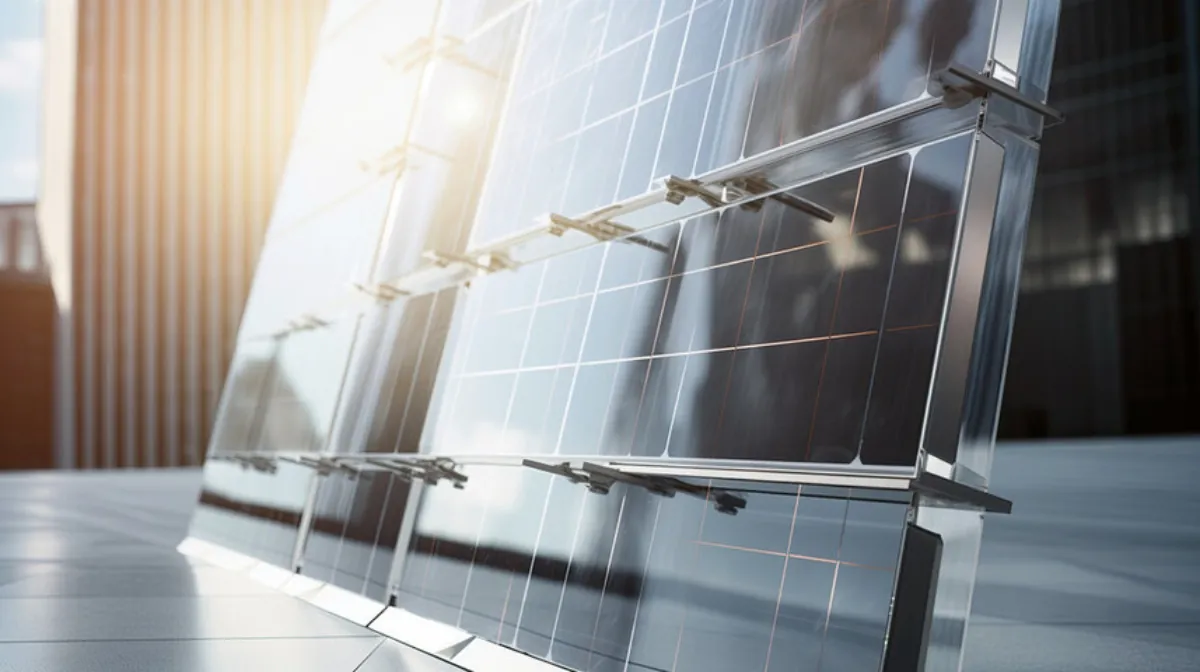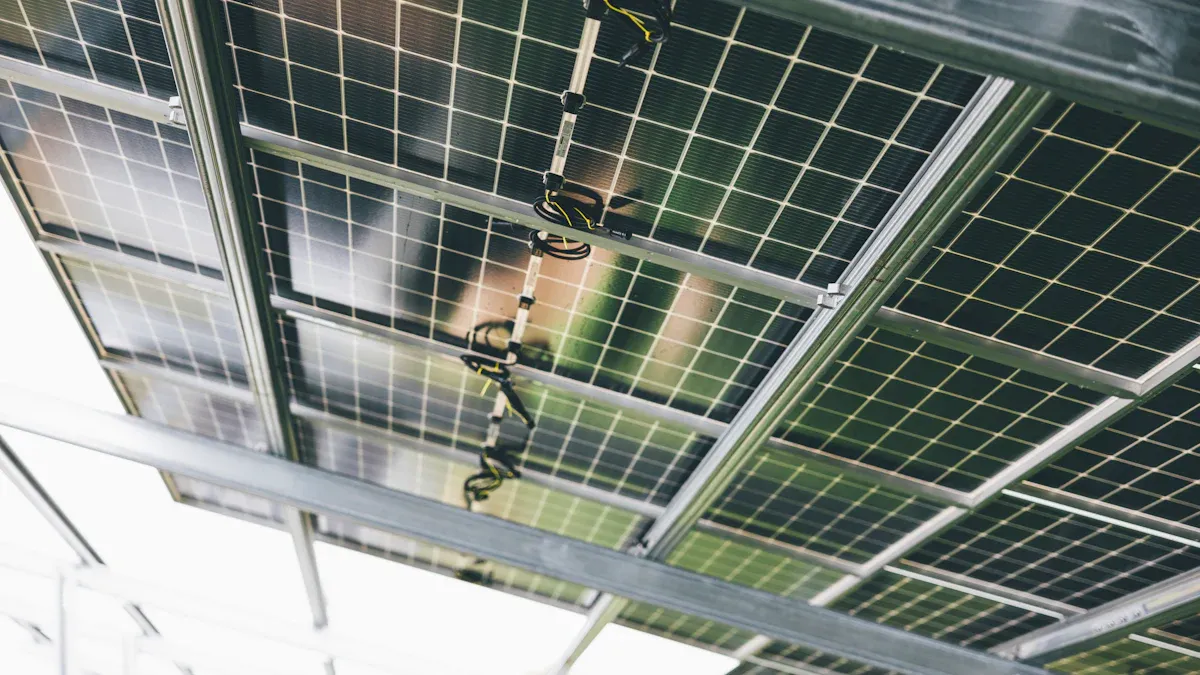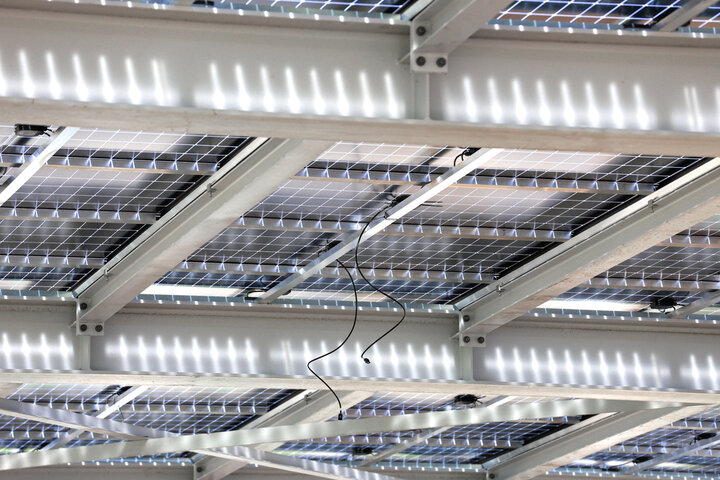+86 17727759177
inbox@terli.net
- All
- Product Name
- Product Keyword
- Product Model
- Product Summary
- Product Description
- Multi Field Search
Views: 0 Author: Site Editor Publish Time: 2025-10-23 Origin: Site
Translucent PV panels help make energy and keep things clear. You can use them on windows or skylights. This technology mixes making power with cool design. It lets buildings, cars, or greenhouses make energy. New changes have made these panels more useful for stopping climate change. People are more interested in them now. You can see this in the global market:
| Year | Market Size (USD) | Projected Growth Rate (CAGR) |
|---|---|---|
| 2024 | 39.24 million | |
| 2025 | 49.51 million | |
| 2030 | 156.95 million | 25.99% |
You should care because these panels give a new way to make power. They also keep places bright and nice.

Translucent PV panels make energy and let in sunlight. They work well for windows and skylights. These panels use sunlight you cannot see. They make power and let daylight into buildings. Translucent PV panels can make buildings look better. They also help save energy and protect the environment. You can use them in many places, like greenhouses and cars. Buying translucent PV panels can lower carbon emissions. This helps the world be more sustainable.
Translucent PV panels are different from regular solar panels. They use special photovoltaics to make electricity from sunlight. These panels look clear and work in a special way. Here is what makes them unique:
Transparent solar panels have photovoltaic cells like normal solar panels.
They use clear materials that let you see light pass through.
These panels catch invisible sunlight, like infrared and ultraviolet.
The light goes to the panel’s edges, where it turns into energy.
You can look through these panels, so they look like glass.
This design lets you use them where you want light and power. You can put them in windows or skylights. You get sunlight and make electricity at the same time.
You might know about regular solar panels. They are dark and block most of the light. People put them on roofs or in fields. They make power but you cannot see through them.
Translucent PV panels are different because they let light pass through. They also catch UV and IR light that you cannot see. You can use them in windows, walls, or glass doors. You do not have to pick between light and power. You get both.
Here is a simple comparison:
| Feature | Traditional Solar Panels | Translucent PV Panels |
|---|---|---|
| Appearance | Opaque, dark | Clear or lightly tinted |
| Light Transmission | Blocks most light | Lets visible light through |
| Placement | Rooftops, fields | Windows, facades, skylights |
| Energy Source | All sunlight | UV and IR wavelengths |
| Main Benefit | High energy output | Power + daylight + design |
Translucent PV panels can make energy and let light in at the same time. You can add them to buildings without making rooms dark. This technology helps you make spaces bright, modern, and save energy.
Translucent PV panels use special photovoltaics to make electricity from sunlight. These panels let visible light go through but catch ultraviolet and infrared rays. The photovoltaic effect starts when the panel takes in these invisible rays. The energy from the light makes electrons move. This movement creates electricity. Look at the table below to see how this works in clear or partly clear materials:
| Key Aspect | Description |
|---|---|
| Absorption | Semi-transparent organic solar cells use parts of sunlight you cannot see. They take in photons outside the visible range and stay clear. |
| Efficiency | These panels get high power conversion by using smart optical designs. |
| Material Design | Scientists create materials that take in near-infrared light but let visible light pass. |
You can make energy and keep your room bright. Semi-transparent covers let some sunlight reach the cell, which helps make power.
There are different types of transparent solar cells in stores and labs. These cells let visible light go through and turn some light into electricity. You can use them in solar windows, screens, and building parts. Here are some features:
These panels use organic or inorganic materials to catch invisible light.
You can find them in glass walls, phone screens, and car windows.
Makers use thin layers of metal oxides or carbon nanotubes to make the panels clear and able to carry electricity.
You can change how clear they are by using different materials and layers.
Big companies making these panels are Heliatek, Brite Solar, Ubiquitous Energy, Onyx Solar Group, and Sharp Corporation.
These panels try to balance how well they work and how they look. Fully transparent solar panels can reach up to 10% efficiency with 86% transparency. Semi-transparent solar panels have about 60% transparency and 7.2% efficiency.
| Type | Transparency | Efficiency Rate |
|---|---|---|
| Fully Transparent | 86% | Up to 10% |
| Semi-transparent | 60% | Around 7.2% |
If you make the panel more clear, it may not work as well. Thin-film materials like amorphous silicon and cadmium telluride help panels stay partly clear and still make energy. Transparent luminescent solar concentrators catch UV and IR light and let visible light go through. These panels make buildings look nice and keep rooms bright while making power.

Transparent solar panels are changing how buildings look and work. Many new buildings use these panels in windows and skylights. They let in sunlight and help make energy. You can see building-integrated photovoltaics in many places. For example:
| Project Name | Location | Description | Energy Contribution |
|---|---|---|---|
| Next Energy Technologies BIPV Facade | Santa Barbara, California | Six transparent windows with OPV coatings | Offsets 20% to 25% of energy consumption |
| Coca-Cola Headquarters | Brussels, Belgium | Semi-transparent PV glazing panels | Generates 40% of the building’s electricity needs |
| Shanghai Tower | Shanghai, China | PV glazing in double-skin façade | Reduces HVAC energy consumption by 20% |
| Copenhagen International School | Copenhagen, Denmark | 12,000 colored solar panels | Generates 300 MWh annually |
| The Edge | Amsterdam, Netherlands | PV glazing for net-zero energy | Maintains optimal workspace lighting |
You can use transparent solar panels in many ways. They can take the place of regular glass in windows and walls. You can pick different sizes and colors for your design. These panels also help keep buildings cool and shaded.
Transparent solar panels help farms grow food and make energy. Semi-transparent solar panels let enough light reach plants. At the same time, they make electricity. Here are some good things about them:
| Benefit | Description |
|---|---|
| Energy Generation | Panels make electricity and let light reach plants. |
| Enhanced Energy Autonomy | Greenhouses can run on their own power. |
| Sustainable Practices | Less need for outside energy. |
| Optimal Photosynthesis | Enough light for healthy crops. |
| Climate Resilience | On-site energy lowers carbon footprint. |
You can see these panels working in real life. In the Netherlands, solar greenhouses cut energy costs by 60%. Farms in California use solar panels to save money and water. Some greenhouses in Africa use solar power to grow more crops.
You can find transparent solar panels in cars and buses. Vehicle-integrated photovoltaics put solar cells on car roofs and windows. These panels help power the car and make it go farther. Some companies use special coatings to let sunlight in. Solar vans can make up to 3.2 kWh each day. Dual-axis tracking helps get even more energy. You can also see these panels at bus stops and parking lots. Some phone screens use this technology too. These uses show how solar panels fit into everyday life.
Translucent PV panels give you many good things. They help you make power and keep rooms bright. You can put them in windows, skylights, or on building fronts. This lets you design buildings in new ways. These panels let sunlight come in, so rooms feel open and sunny. Buildings with these panels can make their own electricity. This helps cities get more clean energy. You can save more energy than with regular solar panels. This is true when you want both power and light inside. The best panels let about 60% of light pass through. This gives a good mix of power and daylight.
You can use these panels in smart windows too. Smart windows help you control how much light and heat come in. This makes your space more comfy. Semi-transparent solar panels can turn your building into a clean energy source.
Tip: You can get points for green building awards like LEED or BREEAM if you use these panels. They help make buildings use less energy and feel better inside.
| Benefit Type | Description |
|---|---|
| Energy Efficiency | Makes clean power and helps buildings use less energy. |
| Indoor Environmental Quality | Brings in more sunlight, so people feel better indoors. |
| Certification Credits | Helps you earn points for green building awards like LEED and BREEAM. |
There are some things to think about before you pick these panels. They do not work as well as regular solar panels. The spaces between the cells make them about 14% less efficient. You need to plan well to get the most power from them.
| Limitation | Description |
|---|---|
| Efficiency | These panels are about 14% less efficient because of bigger gaps between cells. |
| Cost | They cost more to buy, so you need to plan your system carefully. |
| Durability | They last a long time, but not as long as regular solar panels. |
You might pay more for these panels. Putting them in can be harder. Some panels may not last as long as normal ones. Smart windows and other new uses may need more care. Think about these things before you start your solar project.

There are many new things happening with transparent photovoltaics. Scientists at Nanjing University made a clear window coating. This coating lets most light in but still makes electricity. Windows look normal but can now make power. In South Korea, researchers built thin-film solar panels that work on both sides. These panels are good for buildings with lots of glass. Some companies are leading the way. Ubiquitous Energy and Solar Window Technologies turn glass into power sources. Physee and Oxford Photovoltaics put solar cells on windows and building fronts. OnyxSolar makes special glass that saves energy and blocks noise.
| Institution/Company | Contribution |
|---|---|
| Ubiquitous Energy | Transparent solar for windows |
| Solar Window Technologies | Turns glass into power panels |
| Physee | PowerWindow for energy generation |
| Oxford Photovoltaics | Perovskite solar for facades |
| OnyxSolar | Photovoltaic glass for buildings |
You will soon see more solar panels in cities. The thin-film photovoltaic market could reach $33.47 billion by 2033. Cities need new ways to add solar because space is small. Thin-film panels fit on windows, rooftops, and building sides. They are light and bend easily, so they work in many places. More people want these panels as cities grow and need clean energy.
Thin-film solar panels will grow by 8.8% each year from 2025 to 2033.
Cities with little space need more transparent panels.
These panels are great for crowded city buildings.
You can help the Earth by using photovoltaic windows. Buildings use about one-third of the world’s energy. They also make 28% of CO2 emissions. Solar panels in windows can cut energy use and emissions by up to 40%. Some office buildings save 10,000 to 40,000 GJ of energy each year with these panels. The MBR Solar Park shows big projects can lower carbon emissions by millions of tons. When you pick these panels, you help the United Nations Sustainable Development Goals. You help cities get cleaner and work better. Solar technology now removes more greenhouse gases than before. You help build a better future.
You now know how translucent PV panels change energy use. These panels let light go through and also make electricity. You can put them on windows, building fronts, or car roofs. Here are the main things they do:
| Key Features | Description |
|---|---|
| Dual Functionality | Lets light in and makes power |
| Versatility | Works on many surfaces |
| Applications | Used in buildings, cars, and screens |
| Energy Efficiency | Helps use less energy |
| Future Potential | Research keeps making them better |
As technology gets better, you can find more ways to use these panels. Many countries and companies are working to make panels even better. New rules and teamwork help bring more solar panels into everyday life.
| Opportunity Type | Description |
|---|---|
| Technological Advancements | Transparent solar technology is growing quickly |
| Government Policies | Green rules help the market grow |
| Industry Demand | Many businesses want these panels |
| Regional Leadership | Europe is leading with new ideas |
| Collaboration | Teams join together to make progress |
Translucent PV panels go in windows, skylights, and building fronts. They also work in greenhouses and cars. These panels make electricity and let sunlight come in.
Clear solar cells let you see light pass through. They catch invisible light, like ultraviolet and infrared. The cells change this light into electricity. You get daylight and power from one panel.
Yes! These panels help make clean energy in many places. They let you add renewable power to buildings without blocking sunlight. This helps the planet stay healthy.
Translucent PV panels usually cost more money. The technology is new and uses special materials. Prices might go down as more people buy them.
You can put these panels in many older buildings. They fit into windows or glass walls that are already there. Always ask a professional before you start your project.
PV-S150 Solar Panel: Technical Specifications, Performance Analysis, and Installation Guide
PV Panel Specifications: Understanding Solar Panel Technical Parameters
How to Calculate PV Panel Efficiency: Step-by-Step Guide with Formulas and Examples
Understanding PV Module Temperature Thresholds: The Critical 85°C Benchmark for Fire Safety
Comprehensive Guide to Fire Safety in Photovoltaic Systems: Prevention, Risks, and Best Practices
PV Professional's Technical Analysis: Optimizing Polycrystalline Panel Installation and Maintenance